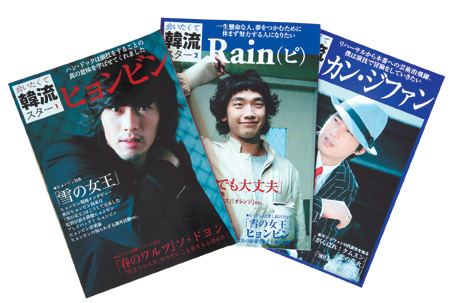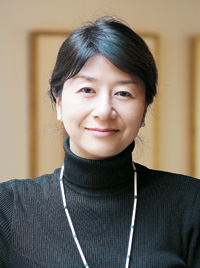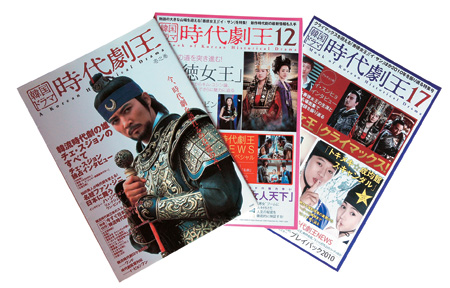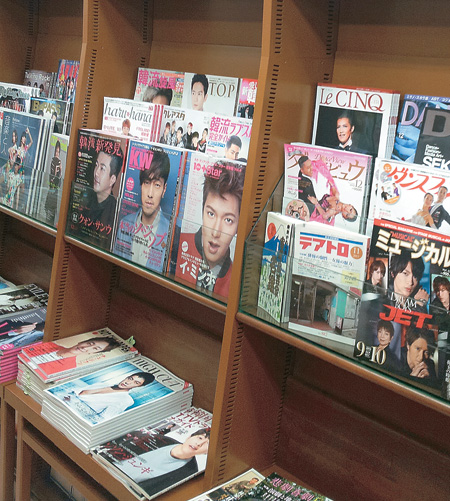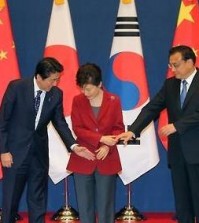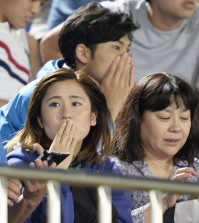- California Assembly OKs highest minimum wage in nation
- S. Korea unveils first graphic cigarette warnings
- US joins with South Korea, Japan in bid to deter North Korea
- LPGA golfer Chun In-gee finally back in action
- S. Korea won’t be top seed in final World Cup qualification round
- US men’s soccer misses 2nd straight Olympics
- US back on track in qualifying with 4-0 win over Guatemala
- High-intensity workout injuries spawn cottage industry
- CDC expands range of Zika mosquitoes into parts of Northeast
- Who knew? ‘The Walking Dead’ is helping families connect
Hallyu drys out in Japanese magazines
Tighter control on Korean content seen as key cause
By Chung Ah-young
Japan has played a crucial role in helping the fledging Korean drama boom in the Asian region grow into the full-grown international hallyu phenomenon. Since the Korean television drama series “Winter Sonata” swept Japan in 2002, Japanese media outlets have fed their fans with Korean cultural content. Among others, Japanese magazines are one of the major channels to pick up the latest news and information about hallyu content in detail and depth.
Chiharu Izumi, a professor at Seokyeong University in Seoul, said, however, that recently hallyu-related content products have been drastically cut due to tighter controls on using the Korean content from 2011.
In Japan, a new breed of publication called “mook” which was coined as a hybrid between a magazine and a book is popular among young consumers. It resembles a magazine in content and format but stays on the shelves much longer than weekly or monthly magazines like a book. The Japanese magazines dealing with hallyu adopt mostly the mook formats.
The professor analyzed the mooks which have published Korean cultural content specializing in Korean epic dramas, films, K-pop and actors/singers have served a pivotal role in boosting the hallyu popularity.
The research is based on the professor’s experience involved in contributing articles to more than 150 magazines or mooks from 2004 to 2012. She presented her research at the recent international forum organized by the Academy of Korean Studies (AKS).
But from 2011, Korean broadcasters and copyright holders such as the entertainment companies stepped up strengthening the restrictions on the copyright of hallyu content, for example, press images. They allow mostly large-sized publishers of their counterparts or affiliates of Korean broadcasters operating in Japan, dealing a serious blow to the small and medium sized publishers where the majority of hallyu mooks are published.
“Now, you can see the number of hallyu magazines is dramatically decreased when you go to the bookstores in Japan compared to that of the past. It means that Japanese hallyu enthusiasts lose the opportunity to consume and know Korea in depth and detail, which can be said that the demands for hallyu is decreasing or in stasis,” she said.
She said that in the peak of hallyu magazines, a special section dedicated to them was situated at the front of the bookstores but now they are stored at the corner of other magazines.
“I have contributed numerous articles concerning hallyu to the Japanese magazines. I was proud of introducing the Korean culture and history through them to the Japanese readers. But I feel sad such an opportunity is being lost,” she said.
As the Japanese people are well known as fanatics of cultural collections, they spare no expense to pay for it. So the magazines were their essential collection items as they included photos of hallyu stars.
“The decline of the hallyu magazines published by small and mid-sized publishers has made them turn to other issues such as Taiwanese pop culture. Also, it is getting harder for the Japanese hallyu journalists to gain access to Korean stars and their events as their agencies are toughening restrictions. It is causing the reduction of hallyu-related jobs and also hampers the sustainable promotion of hallyu there,” she said.
Such an unfavorable condition is combined with the current anti-hallyu sentiment in Japan triggered by Japan’s right-wing groups, the professor argued.
However, the reduction of the hallyu magazines doesn’t necessarily mean hallyu is disappearing. Still the Japanese fans remain loyal to K-pop and dramas. But the decline of the magazines might restrict the deep knowledge and further interest in Korean history and culture. As the online content offers just superficial information,” she said.
When she worked on writing hallyu articles, she visited historical sites such as Joseon royal tombs to describe its history in detail. The online content cannot follow the magazines’ details and depth. That’s why I am feeling so sad,” she said.
To solve this problem, the professor suggested a few things. Korea should turn its way from one-way cultural infiltration to reciprocal exchanges. The two countries should expand more cultural exchanges, while accepting respective cultures and seeking more joint projects for the new creation of the cultural content,” Izumi said.
She also stressed Korean traditional culture should be used in promoting hallyu worldwide. Hallyu has been best promoted to the world through the epic dramas, which evokes the refined and positive cultural images of Korea to the global audience. So Korea should seek a synergy effect by combining pop culture with traditional content,” the professor said.
But as seen in the reduced publications of hallyu magazines due to tightening control on copyright on Korean cultural content particularly in epic dramas, it is needed to adopt more flexible policies for far-flung circulations of hallyu.
“It is true that the political tensions between the two sides are also putting a rift in cultural relations. But the cultural exchanges should be based on purely private-level trade far from political situations although they sometimes are commercial or economically sensitive. I hope the two sides should be open to each other’s culture and seek the future growth in Asia together,” she said.
Izumi came to Korea in 1985 to learn the language and since then, she has contributed to connecting two different cultures through hallyu. She is currently teaching students at Seokyeong University in Seoul.








